Doing Your Own Invasive Plant Control: Definitions, Methods, SAFETY
Successful control and management of invasive plant species requires work, patience, and choices about methods. Your first and paramount concern must be safety — for yourself, your family, your neighbors, your land and all the species that share your environment. Follow safe procedures:
- Know your capabilities and limits — don’t overdo, ask for help.
- Read and study manufacturers’ directions and follow their safe use guidelines.
- Wear the right protective equipment for the job(s) being done.
- Buddy up! Have a “safety spotter” with you when working in the woods.
- Be aware of your surroundings, be aware of others around you.
- Recognize and take precautions against associated hazards like ticks and poison ivy.
Killing unwanted trees, shrubs and vines and preventing resprouting is a primary goal of woodlands improvement. A general rule of thumb to follow when selecting from the toolkit of methods is to choose the method that is the least damaging to the surrounding environment, but that has the most impact on the species you seek to eliminate. Familiarize yourself with the target species and similar species — if you are unsure of identification, seek help before proceeding.
Manual Control: While labor intensive, hand pulling of small to medium sized plants often is very effective because the entire plant and associated rootstock are removed. Small and isolated patches of invasives can be eliminated without concern over herbicide damage to desirable plantings, and without danger of contamination to water or soil.
Herbicide: Several factors need to be considered. Read and follow herbicide label directions carefully. This discussion does not supersede product label instructions, cover first aid, or storage and disposal requirements. Herbicides may be unsuitable for use in certain situations. Carefully read and follow requirements on the herbicide label.
Important considerations
Contamination: Herbicide can enter the watershed and cause extensive damage to water supplies, and will kill or injure wildlife, especially reptiles, amphibians, and invertebrates. Carefully follow the manufacturers’ guidelines for application and the watershed.
Drift: Herbicide drift onto adjacent desirable plantings during foliar spraying is a problem when using handheld, backpack, or tank applicators. Very small quantities of spray, which may be invisible, can damage or kill non-target plants, grasses or crops. Do not spray when wind is blowing toward nontargeted areas.
Flashback: Treated trees and shrubs can release herbicide from their roots. Once herbicide is passively released, it can be absorbed by other nearby and non-target trees and vegetation. Sometimes roots of even different species will share vascular tissue through root grafting. In this case, herbicide will be absorbed by both.
Formulations: Desired performance is gained when the formulation and application method match. Water-soluble solutions are best for cut surface applications; oil soluble solutions work better for basal bark applications.
Uptake: Plants use a natural healing process, called suberization, to prevent insects or disease from entering tissue after a cut or wound. Just as our bodies protect us by forming a scab over a cut, so plants quickly manufacture a layer of corky protective cells over a wound. Herbicide uptake on cut stumps or into wounds is only effective if the application is done immediately — even a delay of one hour can reduce absorption of water-soluble herbicide.
Accuracy: Mixing a stain or dye into the herbicide solution substantially increases applicators’ accuracy and prevents missing or over-treating targeted subjects and/or areas. A stain also indicates personal exposure; inexpensive water-soluble stains wash off later.
Materials: A wide variety of herbicides currently are on the market. Herbicides vary in environmental stability, leachability, selectivity and handling requirements. Systemic herbicides work by entering the plant’s tissues through either the leaves and stems, or the bark or into a cut surface or wound, and then damaging the rootstock and causing death. The systemic herbicides glyphosate (Roundup), triclopyr (Garlon) and triclopyr with 2,4-D (Crossbow) are readily available and may be used in a variety of application forms. Follow label directions for handling, mixing, dilution strength for application, storage and disposal.
Glyphosate: (Roundup) Generally used in a dilute strength for foliar application and may be used in non-dilute form for cut stem and stump, and wound application. Repeat application of foliar spray may be necessary; treating mowed or tilled brush generally is ineffective. Rainfall within 6 hours of application reduces effectiveness. Generally not as likely to leach and degrades in the soil in a short period of time. Do not apply in or near water.
Triclopyr: (Garlon and Crossbow) Garlon is used for woody plants in forests and noncroplands. Crossbow, a combination of triclopyr and 2, 4-D, is used to treat woody plants in forests, noncroplands, pasture and rangeland. They may be used as foliar spray in dilute form. Crossbow may be especially effective for cut stem and stump and wound application. Severe injury to non-target plants may occur on exposure. Where general application is used, do not apply to or near water areas, including irrigation ditches, and do not allow lactating animals to graze treated areas for 1 year following application.
Methods: A variety of application strategies may be used. Foliar spray generally will kill the target within one growing season, although certain species, such as the honeysuckles, may require retreatment. Felling a tree or shrub certainly kills that plant, but resprouts may occur. Basal bark, girdling, and wounding a tree will cause death over time and are most effective in situations where tree felling is not possible, or when the landowner wishes to retain some dead snags for wildlife habitat. Since trees retain sugar and water reserves, these methods may not result in death for 1 to 3 years.
Foliar Spray: Brush up to 15 feet in height can be sprayed, using handheld, backpack or tank applicators. Spraying is most effective when plants are actively growing, but are not under severe stress from very hot weather or lack of moisture. All sides of the plant should be sprayed; generally it is not necessary or desirable to spray plants to the point of saturation and dripping. Take care to avoid spraying non-target plants and drift of spray from wind.
Stump or Stem treatment: Most felled trees and shrubs will try to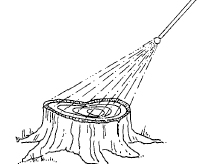 regrow through stump or stem sprouts. Treating the stumps/stems with herbicide immediately after felling reduces or eliminates sprouting. Cut the top of the stump or stem level to allow uniform herbicide application. Thoroughly wet the cambium layer (the thin nutrient carrying layer just inside the bark layer) so that the connective tissue will carry the herbicide to the plant roots. Larger trees need only the outer 2 to 3 inches of the stump treated (the inner layer, or heartwood, actually is dead and contains no plant vascular structures). Smaller tree stumps and shrub stems should be entirely coated. Application can be done by paint brush, squirt or spray bottle. Application is most effective fall through winter when the plant still is taking nutrients down to the roots. Application during the spring when sap is flowing upward is not as successful and may even result in the herbicide rising and flowing out of the stump cut. If herbicide application was delayed after felling, recut the stump down to living tissue before applying herbicide. Water-soluble herbicide formulations are more effective.
regrow through stump or stem sprouts. Treating the stumps/stems with herbicide immediately after felling reduces or eliminates sprouting. Cut the top of the stump or stem level to allow uniform herbicide application. Thoroughly wet the cambium layer (the thin nutrient carrying layer just inside the bark layer) so that the connective tissue will carry the herbicide to the plant roots. Larger trees need only the outer 2 to 3 inches of the stump treated (the inner layer, or heartwood, actually is dead and contains no plant vascular structures). Smaller tree stumps and shrub stems should be entirely coated. Application can be done by paint brush, squirt or spray bottle. Application is most effective fall through winter when the plant still is taking nutrients down to the roots. Application during the spring when sap is flowing upward is not as successful and may even result in the herbicide rising and flowing out of the stump cut. If herbicide application was delayed after felling, recut the stump down to living tissue before applying herbicide. Water-soluble herbicide formulations are more effective.
Basal Bark Treatment: This technique is used to kill the tree by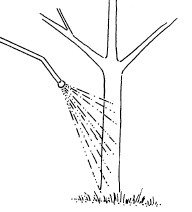 herbicide take-up through the bark. Apply the herbicide to the lower 12 to 18 inches of the tree trunk, thoroughly wetting the bark. Basal bark applications are most successful if Crossbow is used and mixed with diesel oil. Minimize soil saturation around the tree to avoid damage to non-target plants. Application is easiest by spraying.
herbicide take-up through the bark. Apply the herbicide to the lower 12 to 18 inches of the tree trunk, thoroughly wetting the bark. Basal bark applications are most successful if Crossbow is used and mixed with diesel oil. Minimize soil saturation around the tree to avoid damage to non-target plants. Application is easiest by spraying.
Girdling, frilling and wounding: These techniques kill the tree by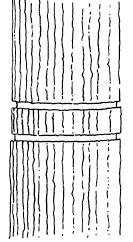
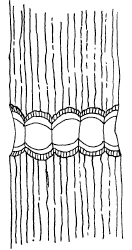 cutting off the flow of sap between the roots and crown by cutting a groove completely around the trunk to a depth of at least 1/2 inch on small trees and 1 to 1 1/2 inches on larger trees. Girdling can be done with an ax, hatchet or chain saw. When done with an ax or hatchet, the girdle is made by striking from above along a line all around the tree so that a notch of wood is removed with each stroke. The width of the notch varies with the size of the tree — from 1 to 2 inches for small trees to as wide as 6 to 8 inches on very large diameter trees. When a chain saw is used, two parallel cuts are made, spaced 3 to 6 vertical inches apart both completely encircling the tree.
cutting off the flow of sap between the roots and crown by cutting a groove completely around the trunk to a depth of at least 1/2 inch on small trees and 1 to 1 1/2 inches on larger trees. Girdling can be done with an ax, hatchet or chain saw. When done with an ax or hatchet, the girdle is made by striking from above along a line all around the tree so that a notch of wood is removed with each stroke. The width of the notch varies with the size of the tree — from 1 to 2 inches for small trees to as wide as 6 to 8 inches on very large diameter trees. When a chain saw is used, two parallel cuts are made, spaced 3 to 6 vertical inches apart both completely encircling the tree.
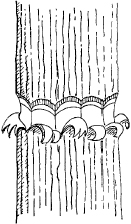
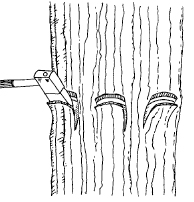 Frilling is a variation of girdling, in which a series of downward cuts are made all around the tree. In this case, the partially severed bark and wood is left attached at the bottom of the cuts. Frilling is done with an ax or hatchet. Wounding, also done with an ax or hatchet, involves far fewer cuts spaced along the trunk. Some species, such as Tree-of-Heaven, are best treated with a single wound. In all cases, water-soluble herbicide is sprayed, squirted or paint-brushed onto the lower part of the cut surfaces. Application should immediately follow the cutting process for best results. These techniques are best done before spring when sap is not flowing up into the tree, since the sap flow would prevent absorption of the herbicide. Water-soluble herbicide formulations are most effective.
Frilling is a variation of girdling, in which a series of downward cuts are made all around the tree. In this case, the partially severed bark and wood is left attached at the bottom of the cuts. Frilling is done with an ax or hatchet. Wounding, also done with an ax or hatchet, involves far fewer cuts spaced along the trunk. Some species, such as Tree-of-Heaven, are best treated with a single wound. In all cases, water-soluble herbicide is sprayed, squirted or paint-brushed onto the lower part of the cut surfaces. Application should immediately follow the cutting process for best results. These techniques are best done before spring when sap is not flowing up into the tree, since the sap flow would prevent absorption of the herbicide. Water-soluble herbicide formulations are most effective.
Materials for this section were adapted from:
Heiligmann, Randall B., 1997, Controlling Undesirable Trees, Shrubs, and Vines in Your Woodlands. Extension Fact Sheet, School of Natural Resources, The Ohio State University, Columbus, Ohio.
Howard, Stott W. and Robert Parker, 1995, Chemical Control for Woody Plants, Stumps and Trees. Cooperative Extension, College of Agriculture and Home Economics, Washington State University, Pullman, Washington.
